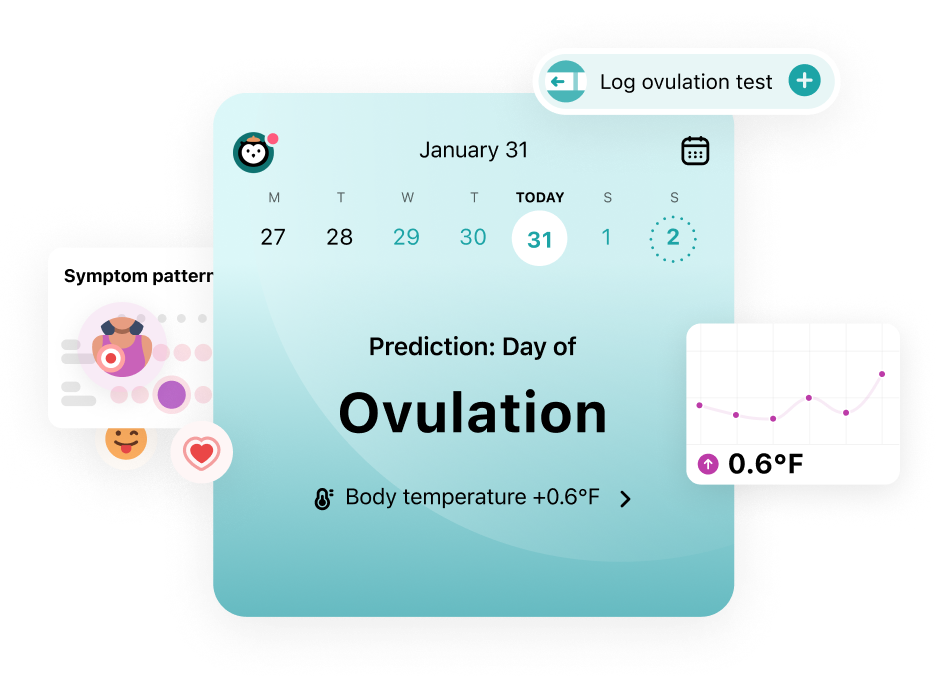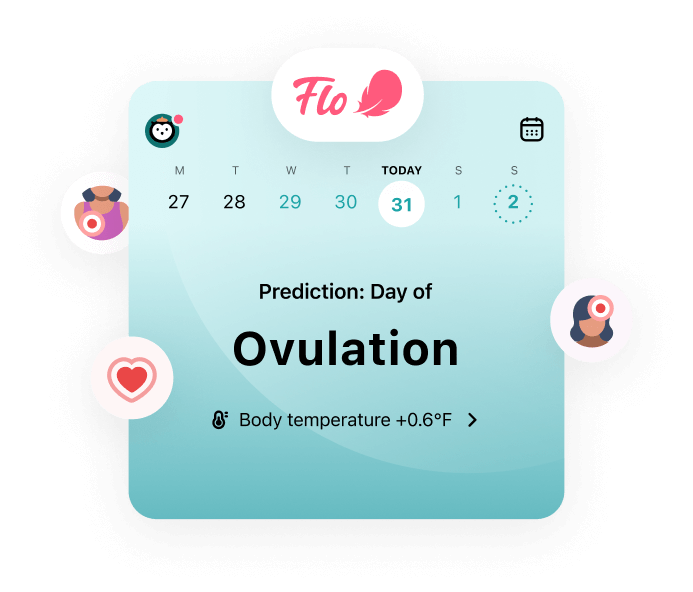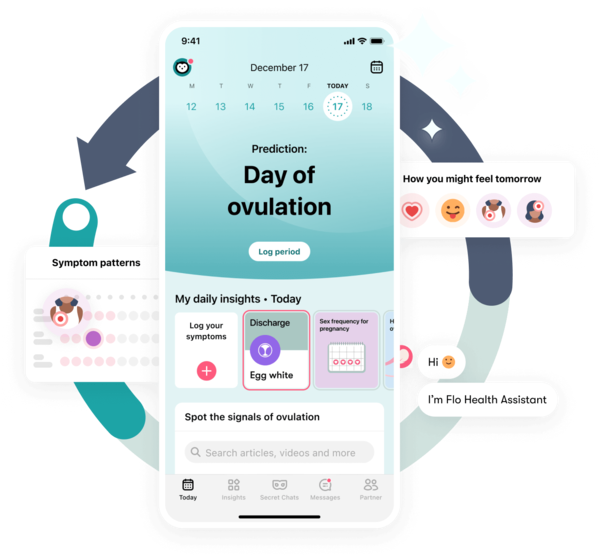Feel confident taking ovulation tests with this guide, which includes hints and tips from a Flo expert.
-
Tracking cycle
-
Getting pregnant
-
Pregnancy
-
Help Center
-
Flo for Partners
-
Anonymous Mode
-
Flo app reviews
-
Flo Premium New
-
Secret Chats New
-
Symptom Checker New
-
Your cycle
-
Health 360°
-
Getting pregnant
-
Pregnancy
-
Being a mom
-
LGBTQ+
-
Quizzes
-
Ovulation calculator
-
hCG calculator
-
Pregnancy test calculator
-
Menstrual cycle calculator
-
Period calculator
-
Implantation calculator
-
Pregnancy weeks to months calculator
-
Pregnancy due date calculator
-
IVF and FET due date calculator
-
Due date calculator by ultrasound
-
Medical Affairs
-
Science & Research
-
Pass It On Project New
-
Privacy Portal
-
Press Center
-
Flo Accuracy
-
Careers
-
Contact Us
What does a positive ovulation test look like?


Every piece of content at Flo Health adheres to the highest editorial standards for language, style, and medical accuracy. To learn what we do to deliver the best health and lifestyle insights to you, check out our content review principles.
If you’re trying for a baby, did you know there are some tips and tricks that could increase your chances of getting pregnant? A good place to start is understanding your menstrual cycle and what’s typical for you, in particular, tracking your ovulation and fertile window.
Your fertile window is the five days before ovulation and the day after. It marks the point in your cycle when you have the best chance of getting pregnant, as this is when your body releases an egg to be potentially fertilized by a sperm. You can use an ovulation-tracking app to log when this occurs. Similarly, taking an ovulation test is one of the easiest ways to see if you’re ovulating. They’re usually pretty accurate too.
So, here’s the lowdown on what a positive ovulation test looks like, what to do when you get one, and what could interfere with these results or cause a false positive.
Key takeaways
- Knowing when you’re in your fertile window and when you might be ovulating can be helpful if you’re planning conception sex. Ovulation marks the point in your cycle when one of your ovaries releases an egg to be potentially fertilized by a sperm.
- One of the easiest and most accurate ways to see if you’re ovulating is to take an ovulation test. You can buy these online or at the drugstore, and they’re considered to be about 99% accurate if used perfectly.
- You can also use an ovulation-tracking app to understand more about your fertile window.
- Ovulation tests work by detecting the increase of luteinizing hormone (LH) in your pee. This hormone rises just before ovulation.
- If you’re considering taking an ovulation test, then it’s worth noting that there are several things that can affect their result. Keep reading to find out more.
- And remember that while Flo can help you understand more about your cycle, it shouldn’t be used as a conception aid.

 Over
7.8M
ratings averaging
4.8/5
*
Over
7.8M
ratings averaging
4.8/5
*
Understand your fertility better with the Flo app
- Learn more about your fertility signals
- Improve ovulation predictions by tracking temperature via Apple Watch
- Log your ovulation test results
 Over
7.8M
ratings averaging
4.8/5
*
Over
7.8M
ratings averaging
4.8/5
*

Trying to conceive?
The Flo app can help you better understand your fertility

 Over
7.8M
ratings averaging
4.8/5
*
Over
7.8M
ratings averaging
4.8/5
*
Understand your fertility better with the Flo app
- Learn more about your fertility signals
- Improve ovulation predictions by tracking temperature via Apple Watch
- Log your ovulation test results
Take a quiz
Find out what you can do with our Health Assistant
Does a positive ovulation test mean you’re ovulating?
The short answer here is: It’s very likely but not 100% certain.
Dr. Sara Twogood, an obstetrician and gynecologist at Cedars-Sinai Medical Group, California, US, who is part of Flo’s expert board, explains: “A positive ovulation predictor kit indicates likely upcoming ovulation. The positive ovulation predictor kit itself does not increase or decrease the potential rate of pregnancy for the month, but it helps guide intercourse to help optimize the chances of pregnancy.”
Ovulation tests work by measuring your luteinizing hormone (LH) levels. This is a hormone that rises just before one of your ovaries releases an egg. Ovulation tests are considered to be 99% accurate in detecting this LH surge when used correctly. So, if your tests come back positive, then it usually means you’ll ovulate within the next 24 to 36 hours if you haven’t already.
However, like so much with your cycle, it isn’t quite that simple. Ovulation tests are very effective at identifying a surge in your LH levels, and in most cases, a positive result does mean that you’ll ovulate very soon if you haven’t already. However, other factors can impact your results. Keep reading to find out more.
How does an ovulation test work?
Understanding how ovulation works may help you better understand your results.
So let’s break down what exactly happens during ovulation. Generally speaking, once a cycle, one of your ovaries releases an egg to be potentially fertilized by a sperm. This is called ovulation. This process is triggered in part by a rise in your LH levels. This means that just before ovulation, your LH levels are at their highest.
Since ovulation can vary from cycle to cycle and person to person, it can be tricky to predict when it’ll happen for you. You can use a cycle-tracking app like Flo to give you a better idea of when this might be. If you’re unsure of when to take an ovulation test, you can also:
- Take an ovulation test three to five days before you think you might ovulate.
- Don’t drink excessive fluids, and make sure you haven’t peed for at least four hours before taking your test.
Using a combination of ovulation tests, ovulation tracking apps, and looking out for signs of ovulation can also help you spot the patterns and understand your cycle better. These include:
- Basal body temperature: Your basal body temperature is your temperature when you’re completely at rest. It increases slightly after ovulation (usually by about 0.5 to 1ºF). You can measure your basal body temperature by using a specialized digital thermometer every morning as soon as you wake up. By logging your temperature every day for several months, you can get an idea of which day it starts to increase during your cycle.
- Cervical mucus: Just before you ovulate, your discharge (also known as cervical mucus) goes through some changes. It may turn from thick, dry, and paste-like to slippery and clear — kind of like egg whites.
Using an app — like Flo’s dedicated ovulation-tracking app — is also one of the easiest and most effective ways to track ovulation and predict your ovulation day. This can help you monitor symptoms, know when to take an ovulation test, and understand the importance of planning conception sex. If you’d like to tap into a community that is also trying to conceive, you can use Flo’s Secret Chats — where you can anonymously speak to millions of other members in a safe and friendly space.
How to read your ovulation test results
It might seem simple, but there are lots of brands of ovulation tests out there, and results can be presented differently. So, before you commit to doing a test, read the instructions that come in your packet. Generally speaking, there are two main types of ovulation tests: stick tests and digital tests. The way the results appear depends on this and the type of brand.
What does a positive ovulation test look like?

With a stick test, you’ll be able to see one control line when you’ve taken the test. If this isn’t there, it’s faulty. Throw the test away and take another. If your test is positive, then another line will appear. This is called the test line. It should be quite a distinctive, dark line. If yours is faint, then consider waiting a day and doing another test.
With a digital test, a “yes” appearing on the screen can indicate a positive ovulation test result. A digital test may also show a smiley face or an upward line, indicating a surge in LH levels, to show a positive ovulation test result.
What does a negative ovulation test look like?

Knowing what a negative test result looks like can be just as helpful as knowing what a positive one looks like.
With a stick test, you should still be able to see the control line. If, after taking the test, you don’t see any other line, or the test line is there but extremely faint, then it could indicate a negative ovulation test result.
With a digital test, a “no” on the screen indicates a negative ovulation test as does a symbol like a sad face or a flat line.
Don’t panic if you get a negative test result. It may mean your LH levels aren’t high enough yet, or there could be an underlying reason. If you think you may still be yet to ovulate, take a daily test in the lead-up to your predicted ovulation day. This should pick up an increase in your LH levels. And if you keep getting negative results, then speak to your doctor.
What could affect your results?
Although ovulation tests are 99% accurate in detecting an LH surge, you may get an inaccurate result for several reasons:
Your menstrual cycle: The average menstrual cycle is considered to be around 28 days long, and ovulation will typically happen around day 14. However, it’s important to remember that if yours is between 21 and 35 days, it’s still considered to be typical. It just means you won’t necessarily ovulate on that day. If you do a test on day 14 of your cycle, but your cycle is typically 22 days long, then you’ll likely get a negative result.
Similarly, if you have an irregular menstrual cycle, it can make it even harder to know when to test — and more expensive if you have to take more tests. Speak to your doctor if you have any concerns.
Hormonal imbalances: Hormonal conditions like polycystic ovary syndrome (PCOS) and thyroid imbalances can cause inaccurate results or false positives due to changing hormone levels. You may, for example, have naturally higher levels of LH.
“People with PCOS have higher baseline levels of circulating LH than those without PCOS, so testing may be ‘positive’ when the LH is not actually surging,” explains Dr. Twogood. It can also prevent ovulation from happening regularly.
Perimenopause: Perimenopause is the years leading up to menopause (your last period) and includes the year after. A doctor can diagnose you as having gone through menopause when you haven’t had a period for 12 months. If you’re perimenopausal, you might have noticed significant changes to your cycle and periods.
Dr. Twogood says: “Ovulation predictor kits are not as accurate during perimenopause. One of the hallmarks of perimenopause is irregular periods caused by irregular ovulation. Hormonal fluctuations in the body that are responsible for ovulation become more erratic and unpredictable. This includes LH.”
- Medication: Some fertility drugs and prescription medication can affect your hormone levels and interfere with ovulation test results. These include Clomid and medicines called gonadotropins, both of which can raise your LH levels.
- Pregnancy: Sometimes, an ovulation test can give a false positive when you are already pregnant and no longer ovulating. That’s because it may test positive in response to an increase in the hormone human chorionic gonadotropin (hCG) instead of LH. The hormone hCG is produced during pregnancy, and it can disrupt an ovulation test because it is chemically similar to LH.
What to do when you get a positive ovulation test result
If you’re trying for a baby, a positive ovulation test is your cue to plan for some conception sex. As your fertile window lasts for the five days leading up to ovulation and the day following, it’s the best time for you to try getting pregnant after a positive ovulation test.
By using Flo’s ovulation tracker, you can better understand the different phases of your menstrual cycle — and, crucially, predict when your ovulation day might be.
More frequently asked questions about positive ovulation tests.
How long after a positive ovulation test are you fertile?
You’re usually fertile for a couple of days. That’s because it may take 24 to 36 hours for an egg to be released after a positive ovulation test, and this egg survives for an additional 24 hours. Dr. Twogood explains: “Ovulation usually occurs about 24 hours, but up to 36 hours, after a positive ovulation predictor kit. The egg remains viable in the female reproductive tract for up to 24 hours. This data means that, from the time of a positive ovulation predictor kit, the fertile window lasts for an additional 48 to 60 hours.”
What are the odds of getting pregnant with a positive ovulation test?
It’s hard to say, as there are so many factors that affect your chances of getting pregnant, including age, lifestyle, and health. On her part, Dr. Twogood estimates: “In general, there is about a 30% chance per month that a healthy woman in her early 30s will conceive.”
Do ovulation tests work during perimenopause?
Ovulation tests are less accurate during perimenopause due to fluctuating hormones and irregular periods. Speak to a health care professional for more information on this.


Hey, I'm Anique
I started using Flo app to track my period and ovulation because we wanted to have a baby.


The Flo app helped me learn about my body and spot ovulation signs during our conception journey.


I vividly
remember the day
that we switched
Flo into
Pregnancy Mode — it was
such a special
moment.
Real stories, real results
Learn how the Flo app became an amazing cheerleader for us on our conception journey.
References
“Basal Body Temperature for Natural Family Planning.” Mayo Clinic, 10 Feb. 2023, www.mayoclinic.org/tests-procedures/basal-body-temperature/about/pac-20393026.
“Cervical Mucus.” Cleveland Clinic, my.clevelandclinic.org/health/body/21957-cervical-mucus. Accessed 16 Dec. 2024.
Choi, Janet, and Johan Smitz. “Luteinizing Hormone and Human Chorionic Gonadotropin: Origins of Difference.” Molecular and Cellular Endocrinology, vol. 383, no. 1–2, Mar. 2014, pp. 203–13, doi:10.1016/j.mce.2013.12.009.
“Luteinizing Hormone.” Cleveland Clinic, my.clevelandclinic.org/health/body/22255-luteinizing-hormone. Accessed 16 Dec. 2024.
“Luteinizing Hormone (LH) Levels Test.” MedlinePlus, 5 Dec. 2023, medlineplus.gov/lab-tests/luteinizing-hormone-lh-levels-test/.
McGovern, P. G., et al. “Absence of Secretory Endometrium after False-Positive Home Urine Luteinizing Hormone Testing.” Fertility and Sterility, vol. 82, no. 5, Nov. 2004, pp. 1273–77, https://doi.org/10.1016/j.fertnstert.2004.03.070.
“Menstrual Cycle.” Cleveland Clinic, my.clevelandclinic.org/health/articles/10132-menstrual-cycle. Accessed 16 Dec. 2024.
“Ovulation.” Cleveland Clinic, my.clevelandclinic.org/health/articles/23439-ovulation. Accessed 16 Dec. 2024.
“Ovulation Home Test.” MedlinePlus, medlineplus.gov/ency/article/007062.htm. Accessed 16 Dec. 2024.
“Patient Education: Infertility Treatment with Gonadotropins (Beyond the Basics).” UpToDate, 25 Apr. 2023, www.uptodate.com/contents/infertility-treatment-with-gonadotropins-beyond-the-basics/print.
“PCOS (Polycystic Ovary Syndrome).” Cleveland Clinic, my.clevelandclinic.org/health/diseases/8316-polycystic-ovary-syndrome-pcos. Accessed 16 Dec. 2024.
“Perimenopause.” Cleveland Clinic, my.clevelandclinic.org/health/diseases/21608-perimenopause. Accessed 16 Dec. 2024.
“Pregnancy Tests.” Cleveland Clinic, my.clevelandclinic.org/health/diagnostics/9703-pregnancy-tests. Accessed 16 Dec. 2024.
“Should You Use Ovulation Strips to Get Pregnant?” Cleveland Clinic, 13 May 2021, health.clevelandclinic.org/should-you-use-ovulation-strips-to-get-pregnant.
“Treating Infertility.” The American College of Obstetricians and Gynecologists, Oct. 2019, www.acog.org/womens-health/faqs/treating-infertility.
Witt, Barry. “Trying to Get Pregnant? Here’s When to Have Sex.” The American College of Obstetricians and Gynecologists, Aug. 2023, www.acog.org/womens-health/experts-and-stories/the-latest/trying-to-get-pregnant-heres-when-to-have-sex.
“Using Ovulation Tools to Predict Fertility.” Mayo Clinic, 13 June 2023, www.mayoclinichealthsystem.org/hometown-health/speaking-of-health/using-ovulation-kits-to-predict-fertility.
“Why Can’t I Get Pregnant?” Johns Hopkins Medicine, www.hopkinsmedicine.org/health/conditions-and-diseases/why-cant-i-get-pregnant. Accessed 16 Dec. 2024.
History of updates
Current version (19 December 2024)
Published (19 December 2024)
In this article

Get your personal guide to fertility
-
Learn how to read your body's ovulation signals
-
Find daily conception tips from our experts
-
Chat with others who are trying to get pregnant




